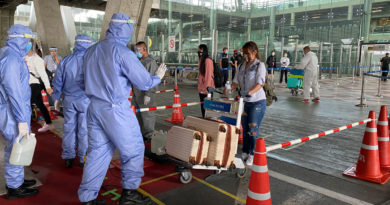SCI-MEDICINE: Chikungunya – a mosquito borne disease which is a silent killer


Chikungunya virus is spread to people by the bite of an infected mosquito. The most common symptoms of infection are fever and joint pain.
Other symptoms may include headache, muscle pain, joint swelling, or rash. Outbreaks have occurred in countries in Africa, Asia, Europe, and the Indian and Pacific Oceans.
There is a risk that the virus will be imported to new areas by infected travelers. There is no vaccine to prevent or medicine to treat chikungunya virus infection. Travelers can protect themselves by preventing mosquito bites.
When traveling to countries with chikungunya virus, use insect repellent, wear long sleeves and pants, and stay in places with air conditioning or that use window and door screens.
Chikungunya virus is transmitted to people through mosquito bites. Mosquitoes become infected when they feed on a person already infected with the virus. Infected mosquitoes can then spread the virus to other people through bites.

Chikungunya virus is most often spread to people by Aedes aegypti and Aedes albopictus mosquitoes. These are the same mosquitoes that transmit dengue virus. They bite during the day and at night.
Chikungunya virus is transmitted rarely from mother to newborn around the time of birth.
To date, no infants have been found to be infected with chikungunya virus through breastfeeding. Because of the benefits of breastfeeding, mothers are encouraged to breastfeed even in areas where chikungunya virus is circulating.
In theory, the virus could be spread through a blood transfusion. To date, there are no known reports of this happening.
Chikungunya virus (CHIKV), probably Asian genotype, was first detected in Cambodia in 1961. Despite no evidence of acute or recent CHIKV infections since 2000, real-time reverse transcription PCR of serum collected in 2011 detected CHIKV, East Central South African genotype. Spatiotemporal patterns and phylogenetic clustering indicate that the virus probably originated in Thailand.
Sporadic cases of chikungunya were identified in Cambodia in 2011. Antibodies to CHIKV have been detected in serum collected in Cambodia in 2007, but the strain could not be identified for those cases.
On March 7, 2012, several cases of rash with fever were reported among village residents of Trapeang Roka in Kampong Speu Province, Cambodia. Subsequent field investigation revealed that four of six blood samples from affected persons were positive for CHIKV by polymerase chain reaction (PCR) at U.S. Naval Medical Research Unit 2 in Phnom Penh.
Investigators from the Cambodian Communicable Disease Control Department, National Malaria Center, Institut Pasteur du Cambodge (IPC), local health centers, and village authorities conducted a seroprevalence study of village residents on March 26 to gather information for response planning and control efforts.
The outbreak affected families throughout the village, and 44.7% of the population tested had evidence of infection by CHIKV, which affected all age groups. Public health agencies and policymakers in affected and nearby unaffected areas of Asia and elsewhere should be alert to the potential spread and reemergence of CHIKV.
The serosurvey in Trapeang Roka on March 26, 2012, documented a CHIKV outbreak in a medium-size rural Cambodian community of 695 residents. It is the first CHIKV serosurvey in Cambodia since the initial isolation of CHIKV in 1961, and the first known serosurvey conducted during a chikungunya outbreak in Southeast Asia.
Chikungunya is rarely fatal. Symptoms are generally self-limiting and last for 2–3 days. The virus remains in the human system for 5-7 days and mosquitoes feeding on an infected person during this period can also become infected. Centers for Disease Control and Prevention/Research Gate. Illustrative map and photo from CDC
















